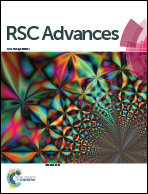Efficient removal of Cd(ii) ions from aqueous solutions via visible capturing
Abstract
A new type of cotton fiber with double functions of visual detection and efficient adsorption of cadmium (Cd(II)) ions in aqueous solutions was successfully prepared via the surface immobilization of 5,10,15,20-tetrakis(1-methyl-4-pyridinio)porphyrin tetra(p-toluenesulfonate) (TPTP). The prepared multi-functional cotton fibers (denoted as C-TPTP fiber) were able to exhibit efficient capture ability for Cd(II) ions with obvious color changes, which confirmed the sensitive detection capability for Cd(II) in the adsorption process. The pH effect, the adsorption kinetics and isotherms of the C-TPTP fiber were also investigated, together with the corresponding color detections for the Cd(II) adsorption performances. The results showed that the C-TPTP fiber reached adsorption equilibrium within 1 hour with a maximum adsorption capacity of 0.4265 mmol g−1 as determined from the Langmuir isotherm model. The color of the C-TPTP fiber changed from brownish to dark green with the increase of the Cd(II) adsorption capacity. The C-TPTP fiber prepared in this paper shows great potential for the early warning and efficient removal of heavy metal ions.


 Please wait while we load your content...
Please wait while we load your content...